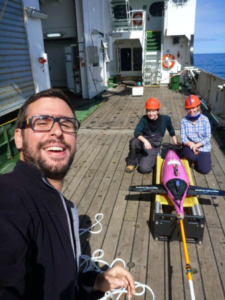by Loïc Houpert
So today, I decided to contribute to the blog by telling you what I like in my work as an observational physical oceanographer.
I am working as a postdoc at the Scottish Association for Marine Science in the beautiful and “occasionally” wet town of Oban. Being a physical oceanographer, I am generally interested in understanding the ocean’s circulation, but right now my interest is more focused: how is the ocean’s heat carried by the currents in the North Atlantic and where is this heat going? The transports of heat and also freshwater by the North Atlantic current system are particularly important for the temperature, precipitation, and wind patterns and strength over the European continent. In my research, I am using autonomous instruments (underwater glider and fixed instrumented lines) that continuously record the state of the ocean.
Going at sea to take measurements and deploy/recover instruments is definitely the best part of my work, although stressful at times. But after coming to shore, the most interesting part of the job is to actually unravel all these big datasets and try to identify physical signals that are associated to the dynamic of the ocean. In addition to having good knowledge of physical oceanography, several factors are important when working on observations: curiosity (being interested in seeing buy ambien online what is in the data), imagination/intuition (finding a way to put together the different pieces of the puzzle) and of course a little bit of skepticism (test the results’ robustness again and again …!).
I really choose to become an observational oceanographer in the second year of my Master, during my research project. It’s true that I had some second thoughts after my first sea-going experience as I was very sick for most of the time of this 7-day cruise… However, 8 months later, during my PhD, I took part in my second cruise and everything went (surprisingly) well. Of course some days were more bumpy than others, but at the same time, this 3-week cruise was in the middle of the Gulf of Lions in winter to sample the impacts of strong storm and deep (2000m) vertical mixing on the marine ecosystems…. All of this to say that you should never stay on a bad first experience when going at sea. Tenaciousness… this is also a good quality if you want to analyze ocean observations!

Illustration 1: Myself blinded by the sun taking a (bad) selfie with Estelle, Karen (the two SAMS glider experts) and Bowmore (the pink glider) after its recovery on the DY053 cruise in July 2016, over Rockall Plateau.